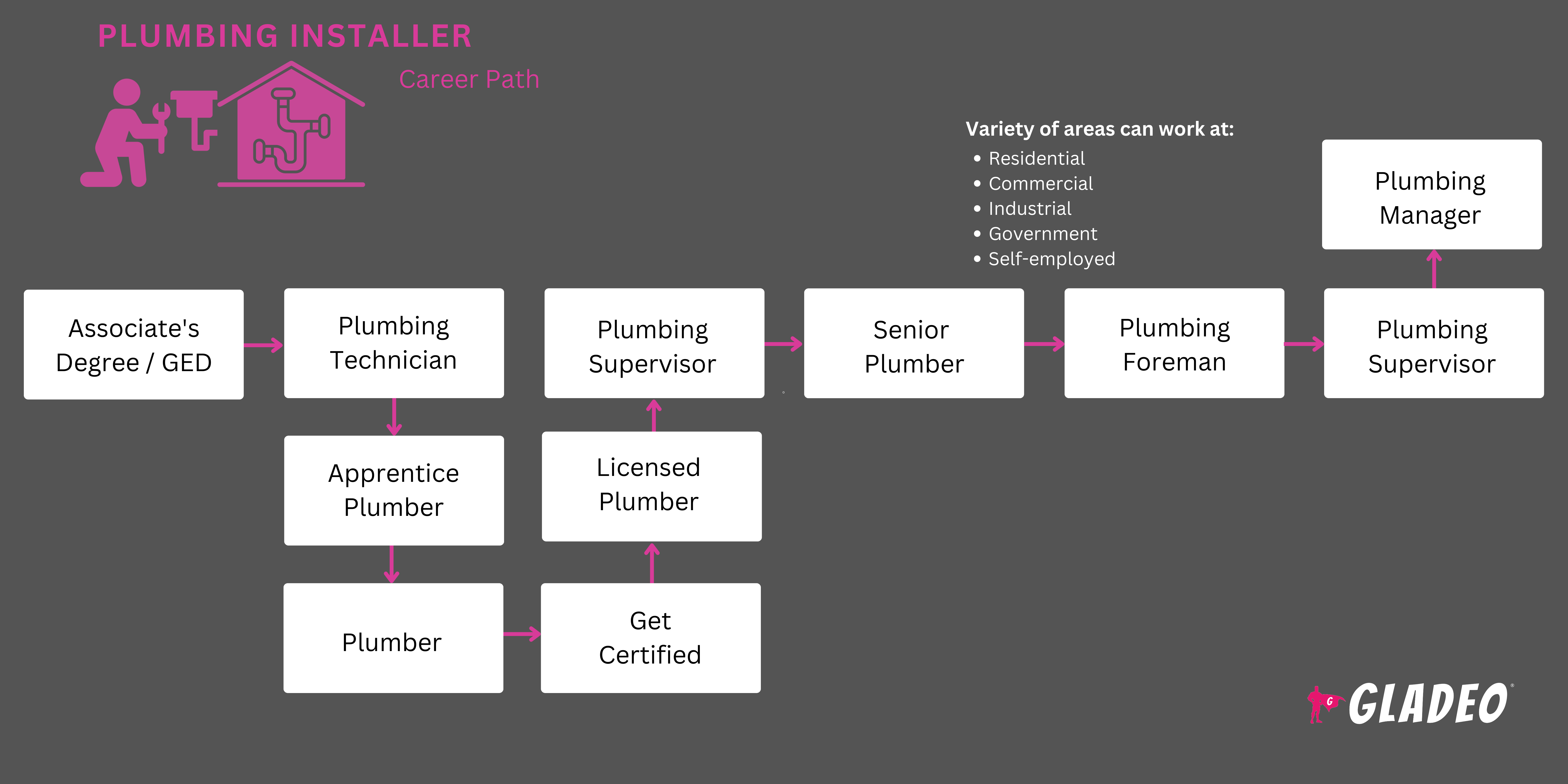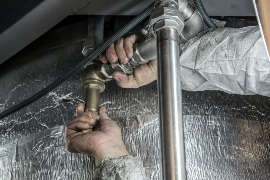Spotlights
Plumber, Plumbing Technician, Plumbing Contractor, Plumbing Supervisor, Pipefitter, Drainage Engineer, Plumbing Inspector, Plumbing Estimator, Gas Fitter
Most of us take indoor plumbing for granted because we grew up with it. But many of us still have relatives who were alive when such conveniences were far from common. Indoor plumbing didn’t start to become accessible until the 1930s. Even by 1940, “nearly half of the houses lacked hot piped water, a bathtub or shower, or a flush toilet” in America!
Fast forward to today and we couldn’t imagine life without running water in our homes, schools, and offices. And it’s all thanks to the hard work of Plumbing Installers—skilled tradespeople who specialize in installing and maintaining the pipes, fixtures, and equipment used for water distribution and disposal. They also install and repair heating, ventilation, and air conditioning (HVAC) units and water heaters.
Their role requires knowledge of complex plumbing systems, the ability to read and interpret blueprints, and a commitment to safety and building code adherence. But their job titles may vary, with some employers using terms like service plumber, commercial plumber, or pipefitter. Whatever term we call them, they work in an indispensable trade that modern society can’t live without.
- Job satisfaction from solving problems and ensuring safe, functional water systems
- Opportunities for independent work and entrepreneurship
- High demand leading to job security
- Potential for advancement and specialization
Working Schedule
- Plumbing Installers typically work full-time, with overtime often required to address emergencies or meet deadlines. Work schedules may include evenings and weekends, especially for those who are self-employed or on call. Frequent travel is needed to reach job sites.
Typical Duties
- Meet with customers, contractors, construction workers, and electricians to go over projects, timeframes, and budgets
- Inspect structures to assess material or equipment needs, establish a sequence of pipe installations, or plan around obstructions
- Review blueprints to determine the layout of systems and materials
- Estimate time, material, or labor costs. Prepare cost estimates or bids
- Inspect work sites for obstructions or holes that could cause structural weakness
- Locate positions for installations, connections, holes, or fixtures
- Lay out drawings of pipe systems, supports, or related equipment, per blueprints
- Plan pipe system layout, installation, or repair
- Select pipe sizes, types, and materials such as supports or hydraulic cylinders
- Install plumbing systems (pipes, fixtures, sinks, toilets, and water heaters)
- Inspect existing systems and components. Replace worn parts, as needed
- Shut off gasses or liquids from pipe sections using valve keys or wrenches
- Install underground storm, sanitary, or water piping systems
- Measure, cut, thread, and bend pipe using hand and power tools or machines
- Attach pipes to walls, structures, or fixtures using brackets, clamps, or welding
- Anchor steel supports from ceiling joists to hold pipes in place
- Replace defective washers and open clogged drains
- Cut openings accommodate pipes or pipe fittings
- Install fixtures, appliances, or equipment designed to reduce water or energy consumption
Additional Responsibilities
- Fill pipes or fixtures with water or air. Observe pressure gauges to detect leaks
- Troubleshoot and fix installation issues to ensure systems function correctly
- Train and mentor junior installers. Direct helpers engaged in pipe cutting, preassembly, or installation of components
- Adhere to codes and safety standards. Ensure work meets legal requirements
- Stay up-to-date with technologies and materials to improve efficiency and quality
- Maintain an accurate inventory of supplies and tools. Order new stock as required
- Document installation processes. Keep records of materials used for each project
Soft Skills
- Ability to work independently
- Attention-to-detail
- Critical thinking
- Dexterity
- English proficiency
- Flexibility
- Organization
- Persistence
- Problem-solving
- Resourcefulness
- Safety consciousness
- Sound judgment and decision-making
- Strength and stamina
- Strong communication skills
- Time management
- Visualization
Technical Skills
- Ability to read blueprints/technical diagrams with layout visualization software
- Proficiency with plumbing tools and equipment (wrenches, pipe cutters, threading machines, and soldering irons)
- Installing smart plumbing devices (touchless faucets, smart water heaters, etc.)
- Experience with green plumbing practices and products
- Expertise in welding and soldering techniques
- Plumbing inspection technologies for diagnosing hidden pipe issues
- In-depth knowledge of building codes and regulations
- Emergency and safety equipment (backflow preventers, gas leak detectors, etc.)
- HVAC systems and tools
- Hydraulic calculations to determine water supply needs and pipe and fixture sizing
- Understanding of water supply and waste management systems (principles of water pressure, venting, and septic system operations)
- Government
- Heavy and civil engineering construction
- Manufacturing
- Plumbing, heating, and air-conditioning contractors
- Self-employed workers
The job of a Plumbing Installer can be physically demanding at times, working in tight spaces, lifting heavy objects, and being exposed to various environmental conditions. There’s also the ongoing risk of personal injuries from tools, materials, and work environments. Sometimes, installers may have to be “on call” in the event of an emergency, which can lead to long work hours.
In addition to being masters of their trade, Plumbing Installers must be devoted to continuous learning to keep up with new technologies such as the Internet of Things (IoT), updated building codes, as well as trends such as green plumbing practices. Any serious flaws in their work can lead to potentially hazardous and expensive leaks.
There’s a high demand for the services of Plumbing Installers in areas experiencing rapid construction growth and where buildings are being retrofitted with modern, efficient systems.
Added to this trend is the growing emphasis on water conservation and sustainable plumbing solutions. Part of these efforts is the increasing use of smart plumbing technology and automation. The integration of IoT in plumbing has revolutionized water systems monitoring and management, allowing for real-time tracking of usage and leak detection, as well as remote control of fixtures. This technology enhances efficiency and convenience while it contributes to reducing unnecessary waste!
Plumbing Installers are often very analytical and hands-on. They may have enjoyed assembling things in their youth, such as sophisticated LEGO sets or other projects, or they could’ve loved building things in shop class with tools. In addition, they might have had a knack for math.
Education
- Plumber Installers need at least a high school diploma or GED but don’t need a college degree. They learn their trade via sponsored apprenticeships which can last 4 or 5 years
- Apprenticeships cover ~2,000 hours of OJT and technical education such as plumbing codes, proper tool and equipment usage, safety, and applicable math and physics
- Some workers participate in pre-apprenticeship programs from organizations such as:
- Home Builders Institute
- Plumbing Heating Cooling Contractors Association
- North American Building Trades Union
- In some cases, Plumbing Installers work their way into apprenticeship programs from other entry-level positions
- Many community colleges and vocational/trade schools feature short, affordable plumbing courses
- Plumbers must pass a state-specific journeyman plumbing test to get licensed. Those who work on gas piping need an additional license
- There are dozens of optional certification programs, including:
- American Society of Plumbing Engineers - Certified in Plumbing Design; Certified Plumbing Design Technician
- Association for Materials Protection and Performance - Internal Corrosion Technologist
- International Association of Plumbing and Mechanical Officials - Backflow Prevention Assembly Tester Certification; Service Plumbing Certification; UPC Residential; Commercial Plumbing Inspector; Plumbing Plans Examiner
- International Code Council - Plumbing Plans Examiner; Commercial Plumbing Inspector
- National Inspection, Testing and Certification Corporation - IAPMO Plumbing Inspector; Journey Level Pipefitter-Steamfitter; STAR Fire SprinklerFitter Mastery
- A college degree isn’t required for this field. Students who do take college courses should ensure programs have a good reputation. Review their Better Business Bureau profile and Google Business feedback
- Consider the cost of tuition, discounts, and local scholarship opportunities (in addition to federal aid)
- Look for courses that can help you develop practical skills
- Think about your schedule and flexibility when deciding whether to enroll in an on-campus, online, or hybrid program
- Note, that some training programs may have connections with local employers!
- Take high school shop classes to get hands-on experience with common tools
- Keep a log of the tools and equipment you learn how to use
- Study math topics including basic arithmetic, measurements, geometry, algebra, trigonometry, fractions, proportions and ratios, and percentages
- Sign up for community college or vocational training classes to learn about plumbing and HVAC equipment installation, maintenance, and repair, plus metalwork, blueprint reading, welding, safety, and CPR/first aid
- Safety is a critical topic to study because plumbing work entails hazards such as hot pipes, risk of falling when working from heights, cuts, exposure to chemicals, waste, mold, and other dangers
- Volunteer or work part-time to build up your practical work experience; it’ll look good on a resume or job application!
- Consider offering a helping hand at a local Habitat for Humanity
- Apply to local pre-apprenticeships or apprenticeship programs when you are ready
- Learn more about plumbing by studying books, articles, and video tutorials
- Watch YouTube videos or shows that capture what the day-to-day is like for this career
- Start an exercise routine to build strength, stamina, and flexibility
- Obtain your driver’s license so you can make it to job sites
- Ask a Plumbing Installer if you can shadow them to learn about day-to-day activities and tools used

- The best way to get any job is to either be qualified or trainable. If you don’t have the necessary academic credentials or work experience, demonstrate on an apprenticeship application that you’re worth investing in!
- Work with your school’s program or career center to locate and apply for jobs or apprenticeships
- Check out sites like Apprenticeship.gov, CareerOneStop, Department of Labor Employment and Training Administration, and Helmets to Hardhats for info on opportunities
- Sign up for alerts on job portals such as Indeed, Simply Hired, Glassdoor, and Zippia, as well as Craigslist for smaller, local opportunities
- If you can work part-time in a related field to learn the ropes beforehand, do so! Shadow your mentor or boss, ask questions, and gain skills
- Call local companies who hire Plumbing Installers or visit their websites for job postings
- Check out examples of Plumbing Installer resumes, if needed. Include applicable keywords in your resume, such as:
- Brazing
- Building Codes
- Caulking
- Copper Pipe
- Dishwashers
- Garbage Disposals
- Hand Tools
- HVAC
- Pipe Installations
- Pipe Systems
- Plumbing
- Potable Water
- PVC
- Torches
- Water Heaters
- Review Plumber interview questions to prepare for interviews
- Tell everyone in your network you’re looking for work!
- Know and comply with safety standards and always wear your protective gear. Nothing angers an employer more than a preventable workplace mishap
- Be on time for work and prepared for the day’s tasks
- Master every skill and perform the highest quality of work possible for your customers
- Take excellent care of your tools and inventory and don’t lose track of items
- Knock out additional courses, volunteer to attend training, and get certified in advanced or specialized duties
- Talk to your boss! Odds are, they’re a wealth of knowledge but sometimes they don’t offer up information unless directly asked
- Take the initiative to study technical manuals and learn directly from manufacturers’ representatives when you interact with them
- Read up on trends and developments
- Train new workers once you’re qualified. Set the bar high for them and lead by example
Websites
- Air Conditioning, Heating, & Refrigeration Institute
- Air Conditioning Contractors of America
- American Fire Sprinkler Association
- American Society Of Heating, Refrigerating And Air-conditioning Engineers (ASHRAE)
- American Society of Plumbing Engineers
- American Welding Society
- Apprenticeship.gov
- Associated Builders and Contractors
- Associated General Contractors of America
- Department of Labor Employment and Training Administration
- Helmets to Hardhats
- Home Builders Institute
- HVAC Excellence
- International Association of Machinists and Aerospace Workers
- International Association of Plumbing and Mechanical Officials
- International Brotherhood of Electrical Workers
- Mechanical Contractors Association of America
- National Association of Home Builders
- National Building Trades Union
- National Center for Construction Education and Research
- National Fire Protection Association
- National Fire Sprinkler Association
- NCCER
- North America’s Building Trades Unions
- North American Technician Excellence
- Online Plumbing Helper
- Plgb
- Plumbing, Heating, Cooling Contractors Association
- PlumbingNet
- PlumbingWeb
- Refrigerating Engineers and Technicians Association
- Refrigeration Service Engineers Society (RSES)
- thePlumber.com
- United Association of Journeymen and Apprentices of the Plumbing and Pipe Fitting Industry
- United Steelworkers
Books
- Plumbing 101, by PHCC Educational Foundation
- Plumbing Complete: Expert Advice from Start to Finish, by Rex Cauldwell
- Plumbing Design and Installation, by L. V. Ripka
- PEX Pipe Plumbing Techniques: A Comprehensive Guide For Reliable And Efficient Installations, by Cairo Richmond
Plumbing Installers have good career prospects, but the job can be very demanding at times. If you’re curious about some alternative career paths, check out the below-related options!
- Boilermaker
- Brazer
- Construction and Building Inspector
- Construction Laborer
- Construction Manager
- Electrician
- General Maintenance and Repair Worker
- Heating, Air Conditioning, and Refrigeration Mechanic
- Industrial Machinery Mechanic
- Machinery Maintenance Worker
- Millwright
- Water Transportation Worker
- Welder
Newsfeed

Featured Jobs

Online Courses and Tools

Annual Salary Expectations
New workers start around $47K. Median pay is $61K per year. Highly experienced workers can earn around $80K.






